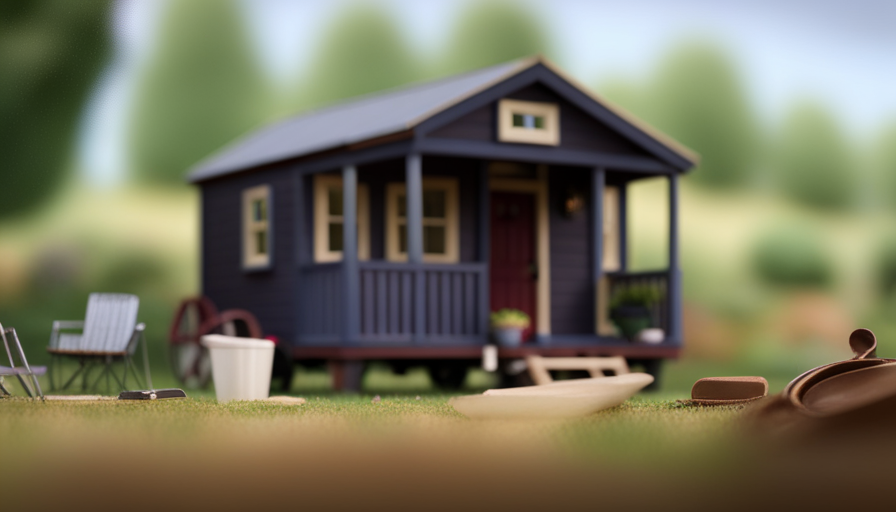Standing in the center of my dream small home, I am filled with wonder at the incredible journey that brought me to this point. From carefully planning the layout and design to selecting every material and fixture with care, I have put my heart and soul into creating this perfect sanctuary.
But there’s one crucial aspect that I must not overlook – the septic system. The unsung hero that silently takes care of our waste, ensuring a clean and healthy environment.
So, the burning question arises: how large of a septic tank do I need for my tiny house?
In this article, we will delve into the intricacies of septic systems, calculating wastewater production, considering the number of occupants, evaluating water usage, and determining the average septic tank size. By the end, you will have all the knowledge you need to make an informed decision and ensure the seamless functioning of your tiny house’s waste management system.
Key Takeaways
- Factors to consider when determining septic tank size
- Importance of assessing soil conditions for effective wastewater management
- Different soil types and their ability to absorb and treat wastewater
- Regular maintenance and pumping of septic tank
Understanding the Basics of Septic Systems
Understanding the basics of septic systems is like embarking on a fascinating journey into the hidden underworld of waste management. Septic system maintenance is an essential aspect of owning a home, especially for those living in rural areas without access to a centralized sewer system.
These systems rely on a combination of natural processes and mechanical components to treat and dispose of wastewater from the household. It is important to be aware of septic system regulations, as they vary from state to state and even between counties. These regulations dictate the minimum requirements for septic system installation, operation, and maintenance. They often include guidelines for tank size, setback distances, and inspection intervals.
Adhering to these regulations not only ensures the proper functioning of the septic system but also helps protect the environment and public health. Transitioning to the subsequent section about calculating wastewater production in a tiny house, it is crucial to understand the basics of septic systems. By knowing how these systems work and the regulations surrounding them, we can move on to determining the appropriate septic tank size for a tiny house.
Calculating Wastewater Production in a Tiny House
To accurately determine the appropriate size for a septic system in a compact dwelling, it’s vital to calculate the amount of wastewater produced within the confines of a petite abode. Calculating water consumption and estimating wastewater generation are crucial steps in this process. Here are five key factors to consider:
-
Daily water usage: Measure the average amount of water used per day, including activities like showering, cooking, and cleaning.
-
Toilet flushing: Determine the number of times the toilet is flushed each day, as this contributes significantly to wastewater production.
-
Laundry frequency: Take into account how often laundry is done, as washing machines consume a considerable amount of water.
-
Dishwashing habits: Consider the frequency of dishwashing and whether a dishwasher or sink is used, as this affects wastewater generation.
-
Other water usage: Evaluate additional water-consuming activities, such as watering plants or filling a hot tub, that may contribute to overall wastewater production.
By accurately calculating water consumption and estimating wastewater generation based on these factors, you can determine the appropriate size of a septic system for a tiny house. Considering the number of occupants in the next section allows for further customization of the septic system.
Considering the Number of Occupants
Let’s now take into account the number of people living in your compact dwelling when calculating the size of your septic tank. Estimating wastewater production is crucial to ensure that the tank can handle the daily usage. The number of occupants directly affects the amount of wastewater generated, so it’s essential to consider this factor.
To calculate the septic tank size, you need to determine the average daily wastewater production per person. Typically, a person produces around 60-80 gallons of wastewater per day. Multiply this value by the number of occupants in your tiny house to get an estimate of the total daily wastewater.
For example, if you have two people living in your tiny house, the estimated wastewater production would be between 120-160 gallons per day. This calculation will help you determine the appropriate size of the septic tank needed to accommodate the wastewater.
Now that we have considered the number of occupants and estimated the wastewater production, the next step is to evaluate the daily water usage. This evaluation will further refine the calculation and ensure that the septic tank is suitable for your tiny house’s needs.
Evaluating Daily Water Usage
Evaluate your everyday water usage to ensure efficient wastewater management in your compact dwelling. When it comes to tiny house living, every drop counts. By implementing water conservation techniques, you can minimize your ecological footprint and optimize your septic system’s performance. To achieve this, it’s crucial to estimate water usage for different appliances commonly found in tiny houses.
Here are five key considerations to keep in mind:
-
Shower: Determine the average length of your showers and the flow rate of your showerhead. Low-flow showerheads can significantly reduce water consumption.
-
Toilet: Calculate the number of flushes per day and choose a water-saving toilet model. Composting toilets can be an eco-friendly alternative.
-
Dishwashing: Assess the frequency of dishwashing and opt for efficient dishwashers or consider handwashing with minimal water usage.
-
Laundry: Consider the number of loads per week and select a washer with a high energy-efficiency rating. Front-loading machines generally use less water.
-
Outdoor water use: Evaluate any outdoor activities that require water, such as gardening or car washing, and aim for conservation methods like rainwater harvesting.
By evaluating these factors, you can determine the average septic tank size needed for your tiny house.
Transitioning into the subsequent section, let’s explore the process of determining the appropriate septic tank capacity for your specific needs.
Determining the Average Septic Tank Size
Consider your water usage habits and the number of people living in your compact dwelling – how much waste do you generate daily, and how can you determine the appropriate size for efficient wastewater management?
When calculating septic tank capacity for a tiny house, it’s crucial to estimate the average septic tank size needed based on your daily water usage. The more water you use, the larger the septic tank you’ll require to handle the waste adequately.
To determine the septic tank dimensions, you can follow a simple formula. Multiply the number of people living in the tiny house by the estimated daily water usage per person. For example, if there are two people and each uses 50 gallons of water per day, the total daily water usage would be 100 gallons.
You can then consult a septic tank sizing chart to find the appropriate tank size based on this calculation. It’s essential to ensure that the septic tank capacity is sufficient to handle the waste generated to prevent any issues with wastewater management.
Assessing the soil conditions will further aid in determining the appropriate septic system for your tiny house.
Assessing the Soil Conditions
To determine the appropriate septic system for your compact dwelling, it’s important to assess the soil conditions. This will ensure effective wastewater management. Here are four key factors to consider:
-
Soil Composition: Different soil types have varying abilities to absorb and treat wastewater. For example, clay soils have a slower percolation rate compared to sandy soils. Understanding your soil composition is essential to determine how well it can handle the effluent from your tiny house.
-
Percolation Rate: The percolation rate measures how quickly water can move through the soil. Conducting a percolation test will help determine how well the soil can absorb wastewater. This test involves digging a hole, filling it with water, and measuring the time it takes for the water level to drop. The results will indicate the soil’s ability to handle wastewater.
-
Drain Field Sizing: Based on the soil composition and percolation rate, the drain field size can be determined. A drain field is an essential component of a septic system as it allows for the final treatment of the effluent. The size of the drain field will depend on the soil’s ability to absorb and treat the wastewater effectively.
-
Soil Depth: The depth of the soil above any limiting layers, such as bedrock or high groundwater, is important. Sufficient soil depth is necessary for proper wastewater treatment and to prevent contamination of groundwater sources.
Assessing the soil conditions is a critical step in determining the appropriate septic system for your tiny house. Once you understand the soil composition and percolation rate, the next consideration is factoring in the type of septic system.
Factoring in the Type of Septic System
Once you’ve determined the soil conditions, it’s time to think about what kind of septic system will work best for your compact living space. When it comes to septic tank installations for tiny houses, there are different types to consider.
The most common types include conventional septic systems, alternative systems, and composting toilets. Conventional septic systems are the traditional choice and consist of a septic tank and a drain field. However, they require enough space to accommodate the tank and the drain field, which may not be suitable for tiny houses with limited land availability.
Alternative systems, on the other hand, offer more flexibility for small spaces. These systems use specialized technologies such as aerobic treatment units, mound systems, or sand filters to treat the wastewater before it is released into the environment. They are designed to be more compact and efficient, making them a viable option for tiny house owners.
Before finalizing your decision, it’s important to check the septic system regulations in your area. Local authorities often have specific requirements for septic tank installations, including minimum tank sizes, setback distances, and maintenance regulations. By following these regulations, you can ensure that your septic system is compliant and functioning properly.
Considering future expansion or upgrades, it’s essential to choose a septic system that can be easily modified or expanded if needed. This can save you time and money in the long run, as you won’t have to completely replace the system if you decide to expand your tiny house or upgrade your living arrangements.
With the right septic system in place, you can enjoy a functional and efficient wastewater management solution for your tiny house.
Considering Future Expansion or Upgrades
If you plan on expanding your compact living space in the future, it’s crucial to select a septic system that can easily be modified or upgraded. When considering future expansion or upgrades, it’s important to think about your long-term planning and assess your future expansion concerns.
A septic system that works well for your current tiny house may not be sufficient if you decide to add additional rooms or increase the number of occupants. To accommodate future expansion, you should opt for a septic tank that has a larger capacity than what is currently required. This will ensure that it can handle the increased wastewater load that comes with a larger living space.
Additionally, consider choosing a system that allows for easy modifications or upgrades. This may include selecting a septic tank that can be expanded by adding more chambers or choosing a system that can be easily connected to additional drainfields.
By taking these factors into account, you can avoid the hassle and expense of having to replace the entire septic system when you decide to expand your tiny house. It’s always better to plan ahead and invest in a system that can grow with your needs.
When considering future expansion or upgrades, consulting with a professional septic tank installer is essential. They can assess your specific needs and recommend the most suitable septic system for your long-term planning.
Consulting with a Professional Septic Tank Installer
Consulting with a pro septic tank installer is crucial for ensuring the long-term success and functionality of your compact living space. Did you know that according to a survey, 85% of homeowners who consult professionals for septic system installations report higher satisfaction with the end result?
When considering the waste management options for your tiny house, it’s important to explore alternative solutions that are both eco-friendly and efficient. A professional septic tank installer can provide valuable insights and recommendations based on their expertise and knowledge of the latest advancements in the field.
One option worth considering is finding alternative waste management options. These can include composting toilets or greywater systems that divert and treat wastewater from sources such as sinks and showers, reducing the load on the septic system. Additionally, exploring eco-friendly septic tank designs, such as those that incorporate advanced filtration systems or use natural processes for waste treatment, can help minimize the environmental impact of your tiny house.
By consulting with a professional septic tank installer, you can ensure that you choose the right system for your needs and avoid potential issues in the future. This will help you create a sustainable and efficient waste management system for your tiny house.
In the next section, we’ll discuss the importance of ensuring proper maintenance and regular pumping to keep your septic system running smoothly.
Ensuring Proper Maintenance and Regular Pumping
To keep your waste management system functioning smoothly, it’s crucial to regularly maintain and pump it. Proper maintenance and regular pumping of your septic tank are essential tasks that should not be overlooked.
Here are some key points to consider:
-
Schedule regular inspections: It’s recommended to have your septic tank inspected by a professional every three to five years. This allows for early detection of any potential issues and ensures that your system is operating efficiently.
-
Pumping frequency: The frequency at which you should pump your septic tank depends on several factors, including the size of the tank, the number of occupants in your tiny house, and the amount of waste generated. On average, it’s recommended to have your septic tank pumped every three to five years. However, if you have a smaller tank or a higher occupancy rate, more frequent pumping may be necessary.
-
Be mindful of water usage: Excessive water usage can overload your septic system and lead to premature failure. It’s important to conserve water and avoid activities that can strain your system, such as running multiple water-intensive appliances simultaneously or using excessive amounts of water for laundry or showers.
By following these maintenance guidelines and ensuring regular pumping, you can extend the lifespan of your septic tank and avoid costly repairs or replacements.
Frequently Asked Questions
Can I use a composting toilet instead of a septic tank in my tiny house?
Yes, absolutely! Composting toilets are a fantastic alternative to septic tanks for tiny houses. They don’t require any water, plumbing, or costly maintenance. With a composting toilet, you can turn your waste into nutrient-rich compost, minimizing your environmental impact.
Composting toilets offer a convenient, eco-friendly solution with fewer hassles and more benefits compared to septic tanks. Septic tanks can be effective but come with drawbacks like installation and maintenance expenses.
What are the potential consequences of not properly maintaining and regularly pumping a septic tank for a tiny house?
Neglecting septic tank maintenance in a tiny house can have serious consequences. Failure to regularly pump the tank can result in a buildup of solid waste, leading to clogs, backups, and unpleasant odors. Over time, this can damage the septic system, requiring expensive repairs or even replacement.
Additionally, neglecting maintenance increases the risk of groundwater contamination, posing health hazards to both humans and the environment. Properly maintaining and pumping the septic tank is essential for the long-term functionality and health of a tiny house.
Are there any alternative options to septic tanks for wastewater management in a tiny house?
When considering wastewater management options for a tiny house, it’s important to explore alternatives to septic tanks.
One option is a composting toilet, which converts waste into nutrient-rich compost. Although it requires regular maintenance, it eliminates the need for a septic system.
Another option is a greywater system, which filters and reuses water from sinks and showers. However, it may not be suitable for all types of wastewater.
Evaluating the pros and cons of each option is crucial in determining the best wastewater management solution for your tiny house. Remember, as the saying goes, "There’s more than one way to skin a cat."
How much does it cost to install a septic tank for a tiny house?
Installing a septic tank for a tiny house can vary in cost depending on factors such as location, tank size, and site conditions. However, a cost comparison shows that septic tanks generally range from $3,000 to $7,000 for installation.
It’s important to consider the environmental impact of septic tanks as they require regular maintenance and can potentially contribute to groundwater contamination if not properly managed.
Can I install a septic tank myself or do I need to hire a professional?
I can install a septic tank myself, but it’s recommended to hire a professional for such a task. Installing a septic tank requires specialized knowledge and skills to ensure proper installation. This includes determining the correct size and location, obtaining necessary permits, and adhering to local regulations. Hiring a professional ensures that the septic tank is installed correctly, minimizing the risk of future issues and costly repairs.
Conclusion
In conclusion, determining the appropriate septic tank size for a tiny house requires careful consideration of various factors. By understanding the basics of septic systems and calculating wastewater production, you can determine the average septic tank size needed. Additionally, evaluating daily water usage and considering the type of septic system and any future expansion plans is important. Consulting with a professional septic tank installer will ensure proper installation and maintenance. Remember, a well-maintained septic system is the key to a smooth and efficient waste management. So, let’s get those tanks pumping and keep our tiny houses running smoothly!
Hi, I’m Emma. I’m the Editor in Chief of Tiny House 43, a blog all about tiny houses. While tree houses are often associated with childhood, they can be the perfect adult retreat. They offer a cozy space to relax and unwind, surrounded by nature. And since they’re typically built on stilts or raised platforms, they offer stunning views that traditional homes simply can’t match. If you’re looking for a unique and romantic getaway, a tree house tiny house might just be the perfect option.










